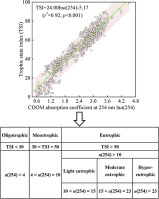Water Research ( IF 12.8 ) Pub Date : 2017-12-26 , DOI: 10.1016/j.watres.2017.12.051 Yunlin Zhang , Yongqiang Zhou , Kun Shi , Boqiang Qin , Xiaolong Yao , Yibo Zhang

|
Chromophoric dissolved organic matter (CDOM) is an important optically active substance in aquatic environments and plays a key role in light attenuation and in the carbon, nitrogen and phosphorus biogeochemical cycles. Although the optical properties, abundance, sources, cycles, compositions and remote sensing estimations of CDOM have been widely reported in different aquatic environments, little is known about the optical properties and composition changes in CDOM along trophic gradients. Therefore, we collected 821 samples from 22 lakes along a trophic gradient (oligotrophic to eutrophic) in China from 2004 to 2015 and determined the CDOM spectral absorption and nutrient concentrations. The total nitrogen (TN), total phosphorus (TP), and chlorophyll a (Chla) concentrations and the Secchi disk depth (SDD) ranged from 0.02 to 24.75 mg/L, 0.002–3.471 mg/L, 0.03–882.66 μg/L, and 0.05–17.30 m, respectively. The trophic state index (TSI) ranged from 1.55 to 98.91 and covered different trophic states, from oligotrophic to hyper-eutrophic. The CDOM absorption coefficient at 254 nm (a(254)) ranged from 1.68 to 92.65 m-1. Additionally, the CDOM sources and composition parameters, including the spectral slope and relative molecular size value, exhibited a substantial variability from the oligotrophic level to other trophic levels. The natural logarithm value of the CDOM absorption, lna(254), is highly linearly correlated with the TSI (r2 = 0.92, p < .001, n = 821). Oligotrophic lakes are distinguished by a(254)<4 m−1, and mesotrophic and eutrophic lakes are classified as 4 ≤ a(254)≤10 and a(254)>10 m−1, respectively. The results suggested that the CDOM absorption coefficient a(254) might be a more sensitive single indicator of the trophic state than TN, TP, Chla and SDD. Therefore, we proposed a CDOM absorption coefficient and determined the threshold for defining the trophic state of a lake. Several advantages of measuring and estimating CDOM, including rapid experimental measurements, potential in situ optical sensor measurements and large-spatial-scale remote sensing estimations, make it superior to traditional TSI techniques for the rapid monitoring and assessment of lake trophic states.
中文翻译:

沿营养梯度的发色溶解有机物的光学性质和组成变化:对监测和评估湖泊富营养化的意义☆
发色溶解性有机物(CDOM)在水生环境中是重要的光学活性物质,在光衰减以及碳,氮和磷的生物地球化学循环中起着关键作用。尽管已经在不同的水生环境中广泛报道了CDOM的光学性质,丰度,来源,周期,组成和遥感估算,但对于CDOM沿营养梯度的光学性质和组成变化知之甚少。因此,我们从2004年至2015年沿营养梯度(低营养到富营养)从22个湖泊中收集了821个样品,并确定了CDOM光谱吸收和养分浓度。总氮(TN),总磷(TP)和叶绿素a(Chl a)浓度和沙奇磁盘深度(SDD)介于0.02至24.75毫克/升,0.002-3.471毫克/ L,0.03-882.66 μ克/升,和0.05-17.30米,分别。营养状态指数(TSI)范围从1.55到98.91,涵盖了不同的营养状态,从贫营养到超富营养。254 nm(a(254))处的CDOM吸收系数为1.68至92.65 m -1。另外,CDOM来源和组成参数,包括光谱斜率和相对分子大小值,表现出从贫营养水平到其他营养水平的显着变化。CDOM吸收的自然对数值ln a(254)与TSI高度线性相关(r 2 = 0.92,p <.001,n = 821)。贫营养湖泊通过区分一个(254)<4米-1,和中营养和富营养化湖泊被分类为4≤ 一个(254)≤10和一个10米(254)> -1分别。该结果表明,CDOM吸收系数一个(254)可能比TN,TP,叶绿素的营养状态的更敏感的单指示器一个和SDD。因此,我们提出了CDOM吸收系数并确定了定义湖泊营养状态的阈值。测量和估算CDOM的几个优点,包括快速的实验测量,潜在的原位光学传感器测量和大范围的遥感估算,使其在快速监测和评估湖泊营养状态方面优于传统的TSI技术。


























 京公网安备 11010802027423号
京公网安备 11010802027423号